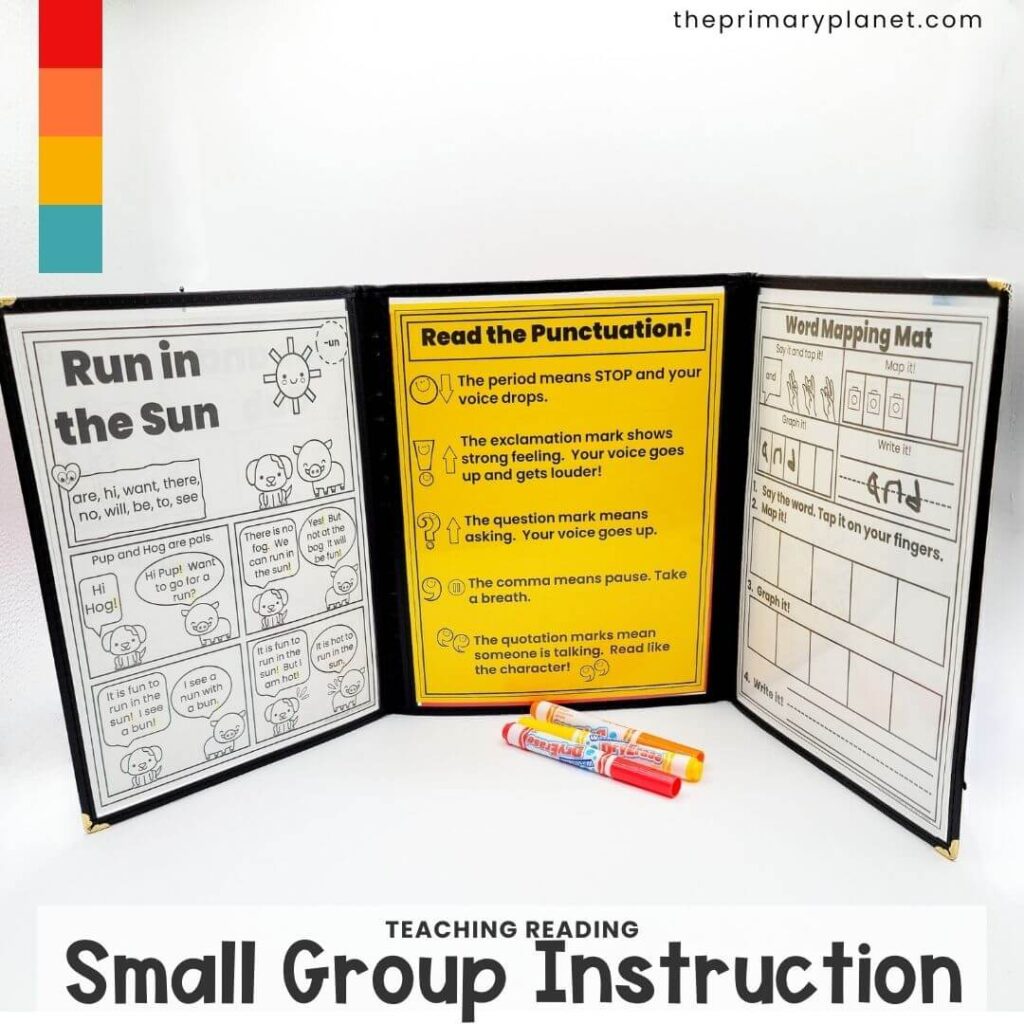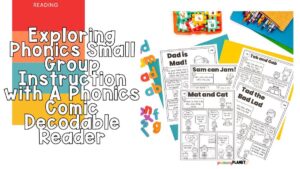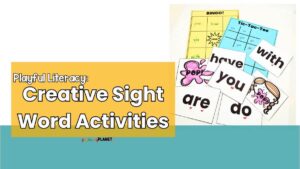
Exploring Phonics Small Group Instruction with a Phonics Comic Decodable Reader
Hey there teacher friends! This post is to explore small group instruction for teaching reading using Phonics Comics. Phonics Decodable Readers with Lessons and Activities!
We know that small group instruction is beneficial when teaching students how to read and has several benefits. Small group instruction is a more efficient use of teacher and student time. Students have more interaction with their classmates and teachers. It also increases opportunities for students to improve their reading and writing skills. So, what does small group instruction for teaching reading using Phonics Comics look like? Read on and see how you can try these super fun Phonics Comics!

Small Group Instruction with Phonics Comics
First, you need to make your groups. “Small group” is usually defined as 2-6 students. There are MANY ways that you can group your students. Student groups should be flexible and based on student needs. Phonics comics are all decodable according to the phonics skill you might be working on. Maybe you have a group that is working on decoding short vowel cvc words. Maybe you have a group that is working on strengthening their sight word recall. Group them how you see fit! YOU are the expert here.
Then, you need to gather your materials for each group. Phonics Comics makes this super easy as it includes everything you need to teach 3 days of Science of Reading aligned small group instruction: sight word cards, decodable readers, handwriting practice, practice worksheets, and word work activity ideas.

Day 1 Small Group Instruction with a Decodable Reader Phonics Comic:
Gather your small group in your small group instruction space. Everything you need to do a lesson with Phonics Comics is laid out for you in the detailed lesson plans included.
I often met with my students on the floor. That gave us all the space we might need. If we met on the floor, I had clipboards or whiteboards to give the students a hard surface for writing.

Before Reading: I always start with a review of the sight words that will be found in the day’s reading. If students are having trouble with some of the words, you can do some word mapping. This is also a good time to talk about any vocabulary that might come up in the text. Phonics Comics also includes a “student glossary” for words that students may need help defining!

Then, pass out the Phonics Comic and look it over. Ask some questions: What do you think this will be about? Who do you think the characters will be?
During Reading: Read the comic together the first time. Then, have the students whisper read the comic and listen in as they read. If students are having trouble with any of the words, make a note and talk about them when everyone is done reading the comic.
After Reading: Take a moment to talk about any of the words that the students may have had trouble with. Then, work on the worksheet together. First, read all the sight words at the top to practice fluency. Next, look at the pictures and circle the correct word. Then, students write the words in their nicest handwriting.
At the bottom of the page, you can dictate the sentence provided in the lesson plans, or you could have students write a sentence using one or more of the words from the top of the page.
Day 2 Small Group Instruction with a Decodable Reader Phonics Comic:
Before Reading: On day 2, the lesson plans usually include a quick phonemic awareness activity. Then, go through the sight words in the box with the heart at the top of the phonics comic
During Reading: Have students whisper read the comic. Note any difficulties the students may be having.
After Reading: Today ask a few of the comprehension questions. Have students point out where they found the answer in the comic. If they don’t know, help them find the answer. Phonics Comics Decodable Readers with Lesson Plans also includes an after-reading activity. It could be a fluency activity, a worksheet or a game!
Day 3 Small Group Instruction with a Decodable Reader Phonics Comic:
Before Reading: On day 3, the lesson plan is to play a word game or activity. Phonics Comics with Lessons and Activities includes instructions and information about 10+ word games and activities that you can do to help reinforce the phonics skills being taught. Then, go through the sight words in the box with the heart at the top of the phonics comic
During Reading: Have students whisper read the comic. Note any difficulties the students may be having.
After Reading: This day has a follow-up writing activity or worksheet. After the second week on a phonics skill, a fun Spelling Test Alternative is provided. This can be used in place of a traditional spelling test, or could be used as dictation or a picture writing prompt!

Beyond Small Group Instruction
Students benefit from re-reading texts to get extra practice and for fluency, so letting your students keep their Phonics Comics in their book boxes for independent reading time is always a good idea. Make the Phonics Comics into a comic book, or put them into a menu holder along with other practice materials for easy differentiation.

You could also send the comics home for students for reading homework. There are so many ways you could use these fun phonics comics in your classroom!
Want to try these fun Phonics Comics? You can find a fun Decodable Phonics Comics freebie in my Free Resource Library! How do you get access to my free resource library? I am so glad that you asked! Sign up for my fun teachery newsletter and you get access to dozens of free teaching resources to make your life a little easier! Interested? Sign up here:
Other Blog Posts You May Enjoy:
- 1 EASY TEACHER HACK FOR SMALL GROUP INSTRUCTION: MENU COVERS!
- 10 UNIQUE WAYS TO TEST SPELLING SKILLS: FUN SPELLING TEST ALTERNATIVES
- READ AND WRITE PHONICS COMICS: TEACHING WITH DECODABLE PASSAGES JUST GOT MORE FUN!
Thank you so much for stopping by and reading my blog post! Pin the image below and share it with your fellow educators. Spread the knowledge!

Happy Teaching,

Share it:
- Read more about: Reading




